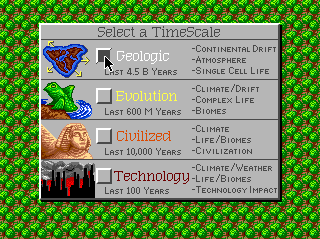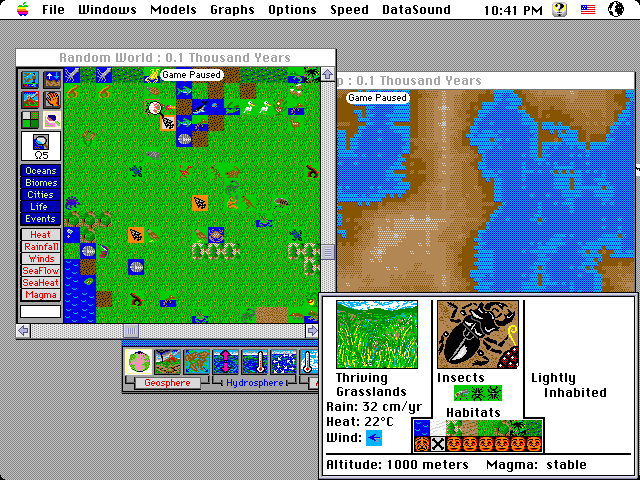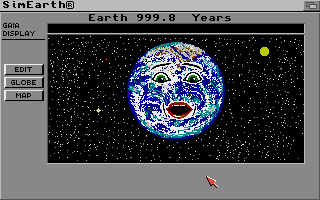Retro Replay Review
Gameplay
SimEarth: The Living Planet places you at the helm of an entire world across a staggering 10 billion years of evolution. You begin in a primordial soup of single-celled organisms and, through careful manipulation of geological and biological factors, aim to shepherd life into the cosmos. The core loop revolves around balancing the planet’s various ecosystems while contending with naturally occurring disasters and anthropogenic threats like pollution and famine.
(HEY YOU!! We hope you enjoy! We try not to run ads. So basically, this is a very expensive hobby running this site. Please consider joining us for updates, forums, and more. Network w/ us to make some cash or friends while retro gaming, and you can win some free retro games for posting. Okay, carry on 👍)
Your toolkit is as awe-inspiring as it is limited: you can raise mountain ranges, shift continental plates, and trigger earthquakes or tidal waves to reset or redirect evolutionary pathways. Each intervention drains from a finite energy pool that you must replenish by fostering robust biomes or guiding technological civilizations to harness renewable resources. This resource management layer introduces genuine tension—every cataclysmic event you unleash comes at the risk of destabilizing your world.
Threats such as disease, war, and global warming ensure that no two playthroughs feel identical. You might spend millennia nurturing lush rainforests only to face a superbug outbreak that ravages your atmosphere, or steer an industrial civilization toward clean energy to stave off runaway greenhouse effects. The strategic depth lies in anticipating long-term repercussions: a single shift in tectonic plates can pave the way for new mountain ranges that influence weather patterns for eons.
Graphics
By modern standards, SimEarth’s visuals are simplistic and largely symbolic, relying on color-coded tiles and icons rather than photorealistic terrain. Landmasses and oceans are depicted in flat, muted hues, while species and civilizations appear as small, animated blips. Despite its dated presentation, the UI conveys vast amounts of data at a glance, from global temperature maps to biodiversity indices.
The minimalistic art style serves the game’s ambition: it shifts focus away from eye candy toward emergent systems. Watching continents slowly drift apart or tectonic boundaries light up with volcanic activity retains a certain hypnotic charm, even if it lacks the flashy shaders of contemporary titles. Detailed graphs and charts accompany every event, turning planetary management into a visually engaging exercise in scientific observation.
On higher-resolution displays, the world map scales well, and the clean interface ensures that critical information—such as atmospheric composition and energy reserves—remains legible. While you won’t marvel at skin-rendered creatures or dynamic weather effects, the aesthetic clarity reinforces SimEarth’s identity as a sprawling, sandbox simulation rather than an action-oriented adventure.
Story
Rather than presenting a linear narrative, SimEarth offers an open-ended saga that emerges from player decisions. There are no set protagonists or scripted cut-scenes; instead, your planet’s history unfolds through evolutionary milestones, environmental upheavals, and the rise and fall of civilizations. This sandbox approach encourages you to craft your own saga—from guiding fish onto land to launching rockets that venture into orbit.
Events such as mass extinctions or ice ages are driven by simulation mechanics, which can be influenced but never fully predicted. This unpredictability generates countless micro-stories: a sudden famine that sparks global conflict, or the discovery of a life-saving vaccine that ushers in a golden age. Each playthrough becomes a unique chronicle of hubris, adaptation, and occasionally, triumph.
While there is no voiced dialogue or written script, the narrative power comes from watching your world “tell” its tale. Unlocking new species classes or seeing civilizations go interstellar delivers a thrill akin to reading an epic in which you’re both author and protagonist. The emergent storytelling is subtle but profoundly memorable for those who appreciate systemic depth over linear plotlines.
Overall Experience
SimEarth: The Living Planet is a masterclass in grand-scale simulation. Its steep learning curve and abstract presentation may deter casual players, but those who persevere are rewarded with a deeply satisfying playground of planetary engineering. Every decision—whether raising a mountain range or curbing industrial emissions—resonates across millennia, granting a sense of cosmic stewardship rarely matched in gaming.
The emotional impact stems from witnessing your efforts bear fruit over geological timescales. Guiding life from single-celled organisms to space-faring societies feels like a personal odyssey, even if it unfolds on a grid of colored tiles. The absence of a traditional score or quest log compels you to define success in your own terms, be it a biodiverse Eden or a technologically advanced utopia.
For buyers intrigued by environmental themes, strategy, and open-ended simulations, SimEarth offers unparalleled depth. Though its visuals and UI reflect its age, the core gameplay remains a compelling exercise in planetary management. If you dream of shaping worlds and witnessing the long arc of evolution, SimEarth: The Living Planet stands as a timeless sandbox for cosmic creativity.
 Retro Replay Retro Replay gaming reviews, news, emulation, geek stuff and more!
Retro Replay Retro Replay gaming reviews, news, emulation, geek stuff and more!









Reviews
There are no reviews yet.